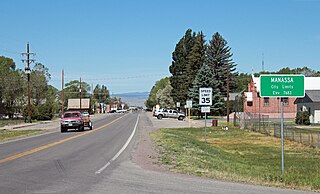
Alamosa is a home rule municipality and the county seat of Alamosa County, Colorado, United States. The city population was 9,806 in the 2020 United States Census. The city is the commercial center of the San Luis Valley in south-central Colorado, and is the home of Adams State University.
Brown v. Board of Education of Topeka, 347 U.S. 483 (1954), was a landmark decision by the U.S. Supreme Court which ruled that U.S. state laws establishing racial segregation in public schools are unconstitutional, even if the segregated schools are otherwise equal in quality. The decision partially overruled the Court's 1896 decision Plessy v. Ferguson, which had held that racial segregation laws did not violate the U.S. Constitution as long as the facilities for each race were equal in quality, a doctrine that had come to be known as "separate but equal". The Court's unanimous decision in Brown paved the way for integration and was a major victory of the civil rights movement, and a model for many future impact litigation cases.

Holbrook is a city in Navajo County, Arizona, United States. According to the 2010 census, the population of the city was 5,053. The city is the county seat of Navajo County.

Antonito is a Statutory Town located in Conejos County, Colorado, United States. The town population was 647 at the 2020 United States Census.

Founded in 1851, the Town of Manassa is a Statutory Town and is the most populous municipality in Conejos County, Colorado, United States. The town's population was 947 at the 2020 United States Census.

Chama is a village in Rio Arriba County, New Mexico, United States. The population was 1,022 at the 2010 census. The village is located in the Rocky Mountains about 7 miles (11 km) south of the Colorado-New Mexico border.

Mexican Americans are Americans of full or partial Mexican heritage. In 2022, Mexican Americans comprised 11.2% of the US population and 58.9% of all Hispanic and Latino Americans. In 2019, 71% of Mexican Americans were born in the United States; they make up 53% of the total population of foreign-born Hispanic Americans and 25% of the total foreign-born population. Chicano is a term used by some to describe the unique identity held by Mexican-Americans. The United States is home to the second-largest Mexican community in the world, behind only Mexico. Most Mexican Americans reside in the Southwest, with over 60% of Mexican Americans living in the states of California and Texas.

Race-integration busing in the United States was the practice of assigning and transporting students to schools within or outside their local school districts in an effort to diversify the racial make-up of schools. While the 1954 U.S. Supreme Court landmark decision in Brown v. Board of Education declared racial segregation in public schools unconstitutional, many American schools continued to remain largely uni-racial due to housing inequality. In an effort to address the ongoing de facto segregation in schools, the 1971 Supreme Court decision, Swann v. Charlotte-Mecklenburg Board of Education, ruled that the federal courts could use busing as a further integration tool to achieve racial balance.

Mendez, et al v. Westminister [sic] School District of Orange County, et al, 64 F.Supp. 544, aff'd, 161 F.2d 774, was a 1947 federal court case that challenged Mexican remedial schools in four districts in Orange County, California. In its ruling, the United States Court of Appeals for the Ninth Circuit, in an en banc decision, held that the forced segregation of Mexican American students into separate "Mexican schools" was unconstitutional because as US District Court Judge Paul J. McCormick stated, "The evidence clearly shows that Spanish-speaking children are retarded in learning English by lack of exposure to its use because of segregation, and that commingling of the entire student body instills and develops a common cultural attitude among the school children which is imperative for the perpetuation of American institutions and ideals."
The Mexican American Legal Defense and Educational Fund (MALDEF) is a national non-profit civil rights organization formed in 1968 by Jack Greenberg to protect the rights of Latinos in the United States. Founded in San Antonio, Texas, it is currently headquartered in Los Angeles, California and maintains regional offices in Sacramento, San Antonio, Chicago, and Washington, D.C.

Sylvia Mendez is an American civil rights activist and retired nurse. At age eight, she played an instrumental role in the Mendez v. Westminster case, the landmark desegregation case of 1946. The case successfully ended de jure segregation in California and paved the way for integration and the American civil rights movement.
The Lemon Grove Case, commonly known as the Lemon Grove Incident, was the United States' first successful school desegregation case. The incident occurred in 1930 and 1931 in Lemon Grove, California, where the local school board attempted to build a separate school for children of Mexican origin. On March 30, 1931, the Superior Court of San Diego County ruled that the local school board's attempt to segregate 75 Mexican and Mexican American elementary school children was a violation of California state laws because ethnic Mexicans were considered White under the state's Education Code. Although often overlooked in the history of school desegregation, the Lemon Grove Case is increasingly heralded as the first victory over segregative educational practices and as a testimony to the Mexican immigrant parents who effectively utilized the U.S. legal system to protect their children's rights.

The League of United Latin American Citizens (LULAC) is the largest and oldest Hispanic and Latin-American civil rights organization in the United States. It was established on February 17, 1929, in Corpus Christi, Texas, largely by Hispanics returning from World War I who sought to end ethnic discrimination against Latinos in the United States. The goal of LULAC is to advance the economic condition, educational attainment, political influence, housing, health, and civil rights of Hispanic people in the United States. LULAC uses nationwide councils and group community organizations to achieve all these goals. LULAC has about 132,000 members in the United States.
The Westminster School District (WSD) is a school district in Orange County, California, established in 1872 and headquartered in Westminster. It operates schools in Westminster, Garden Grove, Huntington Beach, and Midway City.

The Hispanos of New Mexico, also known as Neomexicanos or Nuevomexicanos, are Hispanic residents originating in the historical region of Santa Fe de Nuevo México, today the US state of New Mexico, southern Colorado, and other parts of the Southwestern United States including Arizona, Nevada, Texas, and Utah. They are descended from Oasisamerica groups and the settlers of the Viceroyalty of New Spain, the First Mexican Empire and Republic, the Centralist Republic of Mexico, and the New Mexico Territory.

Felicitas Gómez Martínez de Méndez was a Puerto Rican activist in the American civil rights movement. In 1946, Méndez and her husband, Gonzalo, led an educational civil rights battle that changed California and set an important legal precedent for ending de jure segregation in the United States. Their landmark desegregation case, known as Mendez v. Westminster, paved the way for meaningful integration and public-school reform.

School segregation in the United States was the separation of students based on their ethnicity. Where they were not prohibited from schools and denied an education, various minorities were barred from schools for whites. The U.S. Supreme Court rules Blacks were not and could never be U.S. citizens and overturned the 1875 Civil Rights Act, passed by Republicans during the Reconstruction era, in 1883. Segregation laws were dismantled in the late 1960s by the U.S. Supreme Court. Segregation was practiced in the north and segregation continued longstanding exclusionary policies in much of the South after the Civil War. School integration in the United States took place at different times in different areas and often met resistance. Jim Crow laws codified segregation. These laws were influenced by the history of slavery and discrimination in the US. Secondary schools for African Americans in the South were called training schools instead of high schools in order to appease racist whites and focused on vocational education. After the ruling of Brown v. Board of Education, which banned segregated school laws, school segregation took de facto form. School segregation declined rapidly during the late 1960s and early 1970s as the government became strict on schools' plans to combat segregation more effectively as a result of Green v. County School Board of New Kent County. Voluntary segregation by income appears to have increased since 1990. Racial segregation has either increased or stayed constant since 1990, depending on which definition of segregation is used. In general, definitions based on the amount of interaction between black and white students show increased racial segregation, while definitions based on the proportion of black and white students in different schools show racial segregation remaining approximately constant.
Hispanic and Latino Coloradans are residents of the state of Colorado who are of Hispanic or Latino ancestry. As of 2020, Hispanics and Latinos of any race made up 21% of the state's population, or 1,269,520 of the state's 5,770,545 residents.
Del Rio ISD v. Salvatierra is a Texas Supreme Court ruling filed in 1930.

Delgado V. Bastrop Independent School District was a Federal Circuit court case based out of Bastrop county that ruled against the segregation of Mexican-Americans in the public schools of Texas. The court's decision was argued on the standpoint of the Mendez et al. v. Westminster et al. court case and lack of Texas law for segregation of those of Mexican descent, and also stated that Mexican-Americans were separate from African-Americans as had been ruled in Plessy v. Ferguson. This case stated that except for the instance of separating individuals based on severe language difficulties in first grade, the school districts could not segregate their schools between Anglos and Mexican-Americans; moreover, the local school leaders and districts needed to take active action against it or they would also be liable for the results of segregated education. Though this case helped establish a baseline in the law against Mexican-American segregation in public schools, it took many more years and future lawsuits for action to follow through with the actual rulings of the court.














